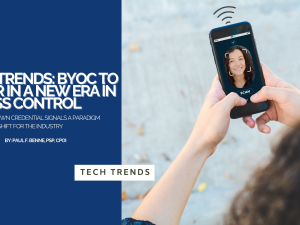Technophiles have long admired wearable technologies, from the high-tech gadgetry embraced by James Bond, Maxwell Smart and Agent K (all Hollywood references) to the very popular watch calculators that had tech geeks drooling in the 1980s.
Fast-forward to today and the evolution of wearable technology has grown exponentially. A host of wearable technologies not only do what was once only dreamed of but are capable of much more. It is now commonplace for wearable users to employ watches, rings, and other wearable devices to provide them with hyper-insight to health and fitness information. These devices can record heart rate, respiration, temperature, steps, motion, etc. and compare that data to a baseline to determine performance and abnormalities.
Wearable devices know its user’s unique biometrics and that information can be used to validate identity – not only for access control but also for ordinary transactions. These devices can monitor for duress and medical conditions that may require third-party involvement, and they can also be a tool for employee accountability. I can imagine a slight shift to a more dystopian future, where wearables are a means to instill and enforce a social credit score, adding and subtracting points for the performance or lack of performance of predefined acts.
As software and hardware manufacturers are actively at work creating the devices and platforms, the need for wearable security and safety devices continues to grow and will become accepted as commonplace. As this technology has continued to develop and improve, it is being embraced and adopted into various industry sectors, including for security; in fact, the impressive capabilities of wearables are impressive, it is only the tip of the iceberg when it comes to using this information for security purposes.
Identity Management
The security industry’s continuously evolving need to confirm someone’s identity is playing out as manufacturers continue to reinvent access card and reader technologies. These advancements are necessary to keep up with the sophistication of adversaries that have learned how to exploit previous technologies.
With complexities of validating a user’s authorization to gain access to a secure area made difficult without adding some level of biometrics to the validation process, wearable technology can be the answer. A health and fitness wearable has more uniquely identifiable data on its user than a fingerprint does. Someone’s walk, gait, stride, and dominant-side characteristics all have unique individual attributes that are continuously recorded. This is also true for someone’s heartbeat, respiration, keystroke motion when typing, and many other recorded points of uniquely identifiable biometrics. Thanks to wearables these attributes are always being collected and recorded, and developers are now researching how this unique biometric information can be used to validate identity and thus increase the level of security in identity authentication.
Personal Security
The evolution of wearable devices does not stop there; in fact, a whole new world of applications is being developed to gain insight, increase efficiency, and provide safety and security for the device’s user. These functions can be categorized in four areas for use in a safety and security capacity.
- Health and fitness:
Because it has a large consumer-based demand, this category is by far the most developed and advanced. It is also a bit sensitive, as employees are not often willing to share this data with employers.
That said, applications that detect a possible duress condition such as fall detection, heart rate spikes, and motion detection are being used effectively in law enforcement, security, and healthcare industries to monitor staff for wellbeing, while also triggering third-party alerts should a metric fall outside of a normal range. Some employers are also encouraging staff to use wearables to be informed of the negative effects of long hours at a desk behind a computer, allowing the employee to take corrective measures.
- Access and employee controls:
Wearables specifically for access control and identity verification, such as those made by Toronto-based Nymi (www.nymi.com), are at the forefront of development. This technology also supports the use of wearables for time-and-attendance and real-time occupancy data. As previously mentioned, the benefits of being able use biometric data to confirm identity makes this category particularly useful in security. The user validates to the wearable device, and the wearable device validates to the edge appliance. - Documentation and accountability:
Wearables are being used for documentation and accountability of employees in the field. Already ubiquitous in the law enforcement industry, body cameras that record and stream video are also catching on among delivery drivers, healthcare workers and more. Additionally, internet-connected uniforms can broadcast location, speed, and direction of the wearer; smart watches can send location and bio data; and smart glasses can provide two-way information sharing. These devices are almost always connected to Computer Aided Dispatch (CAD) systems, and this connectivity allows for the sharing and rapid dissemination of data to aid in the response to incidents. - Personal protection and safety:
Devices used to communicate duress come in many variations of styles and functionality. Most security executives are familiar with PERS devices, but many manufacturers are embedding this technology in more consumer-friendly packages. Birdie, for example, is a small keychain-type device that allows the users to separate the device from the keychain to create a duress event. Doing so will trigger a local audible alarm as well as communicate via Bluetooth to the user’s smartphone to send location data and other metrics to a list of recipiences preprogrammed into an app. While the company is focused on marketing the device to women, its clearly a good choice for anyone. Similar devices from other companies can come in the form of jewelry and decorative pendants.
This article originally appeared in the September 2023 issue of Security Business magazine. Paul F Benne is the President of Sentinel Consulting and has over 35 years in the protective service industry.







